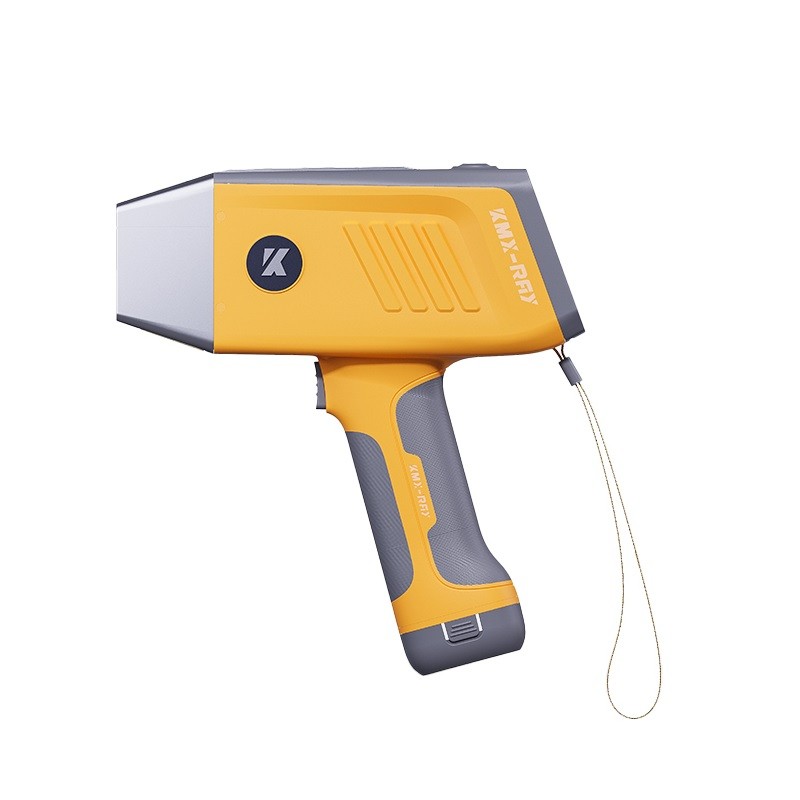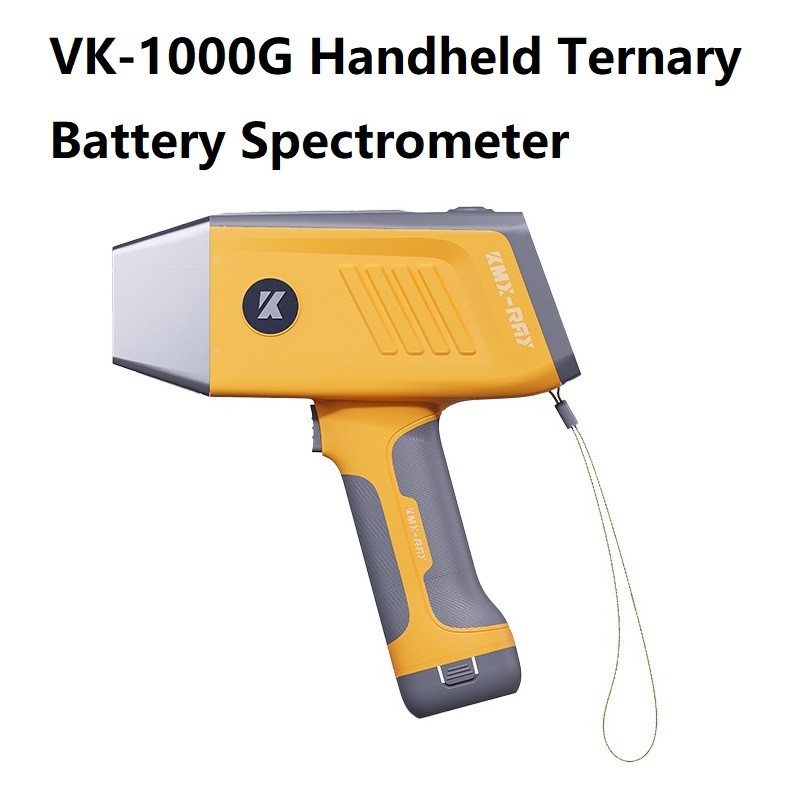VK-1000G Handheld Ternary Battery Spectrometer
The VK-1000G handheld ternary lithium battery spectrum analyzer is designed to detect elements such as Ni (nickel), Co (cobalt), Mn (manganese), and their respective contents. It facilitates the
rapid differentiation of material types, including lithium battery types such as 622, 532, 111, as well as distinguishing between cathodes, anodes, lithium batteries, lead-acid batteries, lithium iron
phosphate batteries, high-rate power batteries, ternary power batteries, pouch cells, 18650 lithium cells, polymer power cells, aluminum shell cells, flat batteries, disassembled good cell cores, and
electric vehicle battery packs.
In applications for exploring metals used in batteries, portable XRF analyzers offer faster and reliable data compared to traditional XRF devices in laboratories. They enable exploration personnel to
make accurate decisions swiftly and assist in sample screening for more suitable samples for laboratory analysis. This aids in reducing exploration costs and increasing return on investment. Portable
XRF analyzers screen samples to identify appropriate ones for analysis. This sample preparation allows portable XRF analyzers to generate high-quality quantitative data that closely aligns with
laboratory analysis results.
The handheld XRF spectrometer has various applications in the analysis of ternary lithium batteries, which have seen rapid market growth recently, increasing demand for both positive and negative
electrode materials. Ternary materials mainly comprise NCM (Nickel Cobalt Manganese) and NCA (Nickel Cobalt Aluminum). Among these, NCM currently dominates the ternary materials market.
Mishandling of lithium batteries can cause explosions. To prevent such safety incidents, ensure battery lifespan, and aid in recycling to prevent environmental pollution, the handheld XRF spectrometer
is pivotal.
**Applications of Handheld XRF Spectrometer in Ternary Lithium Battery Analysis:**
1. **Identification of Battery Cathode Materials:**
- Numerous severe battery incidents in the past were often due to substandard batteries. Handheld XRF spectrometers are used to determine the elements and their concentrations in the battery's
cathode materials, ensuring the batteries meet quality standards.
2. **Quality Control in Battery Manufacturing:**
- For battery manufacturers, maintaining high-quality materials, semi-finished, and finished products is crucial. Recommended handheld XRF spectrometers, like those by Kromis, aid inspection
personnel in accurately testing each lithium battery sample non-destructively, ensuring efficient and expedited product inspection.
3. **Recycling and Sorting of Used Batteries:**
- Used batteries contain substantial amounts of heavy metal elements like manganese, cobalt, nickel, along with highly toxic substances such as lithium hexafluorophosphate in their electrolytes.
Improper disposal can cause severe environmental damage.
- Before recycling, advanced testing equipment like handheld XRF spectrometers are used for rapid and accurate on-site analysis, not only preventing environmental pollution but also increasing
battery utilization efficiency, creating new profit opportunities, and reducing battery production costs.
- Handheld XRF spectrometers enable on-site testing and swift classification of a large number of used batteries. Within seconds, they determine the battery type and component composition,
providing essential information for swift and reliable judgments during transactions between buyers and sellers.
The handheld ternary lithium battery spectrometer is a portable device designed for analyzing ternary lithium batteries. It enables the detection and quantification of elements such as Ni (Nickel),
Co (Cobalt), Mn (Manganese), and swiftly distinguishes various material types, including 622-type, 532-type, 111-type lithium batteries, positive and negative electrodes, lithium batteries, lead-acid
batteries, LiFePO4 batteries, high-rate power batteries, ternary power batteries, soft-pack cores, 18650 lithium cores, polymer power cores, aluminum shell cores, tablet batteries, disassembled battery
cores, and electric vehicle battery packs.
This device serves as an efficient tool for elemental analysis and identifying materials in a variety of lithium battery types, offering quick and accurate results for Ni, Co, Mn, and other relevant elements,
ensuring the differentiation of distinct battery types and components.
VK-1000G handheld ternary lithium battery spectrometer technical specifications:
1. Environmental requirements: Temperature range: -20~50°C, Relative humidity: 10~90% (non-condensing). The workplace should not have strong magnetic fields, vibration sources, or high-frequency
equipment nearby.
2. Waterproof, dustproof, scratch-resistant, and shockproof; The instrument has excellent balance and can stand on the workbench during testing without the need for hand support. It features a one-key
button design, allowing extended operation without fatigue.
3. Excitation source: High-power micro direct plate electronic X-ray tube with an excitation voltage of 35kV; No high-voltage cables, no radio frequency noise, better X-ray shielding, and enhanced heat
dissipation.
- Fixed voltage of 35kV, current of 100uA (from Moxtek in the US). Standard equipped with Ag target, while W target and Rh target can be customized.
4. Utilizes KMX technology for higher X-ray counting rates; The instrument's interior shell is coated with conductive silver paint and the circuit board has electronic shielding fabric to prevent
electromagnetic interference and ensure stable elemental resolution.
5. Detector: Si-pin detector capable of simultaneously recording analysis data and spectral graphs; Moxtek Si-PIN detector (6 mm2 energy resolution of 170eV FWHM).
- Test elements: Alloy mode customized for conventional lithium battery elements (Co, Ni, Mn, Cu); Ore mode (Co, Ni, Mn, Cu, residual LE elements).
6. Computational method: KMX-FP non-standard sample testing method specifically adjusted for the lithium battery recycling industry.
7. Test initiation controlled by a touch or trigger pull; The testing process does not require long holding of the trigger. According to customer needs, continuous sample testing by holding the trigger
is also possible.
8. Safety features: Trigger lock function with adjustable lock duration; When activated, both touch and trigger operations are disabled.
9. Battery: Original 7.2V large-capacity rechargeable lithium battery; Battery status can be directly checked at the bottom without removing the battery; Comes with 2 lithium batteries as standard.
10. Easy replacement of thin film windows without the need for tools.
11. Operating system: Windows CE 6.0 dedicated industrial-grade instrument operating system for safety and reliability.
12. Data display: Elements can be arranged in preferred order or their display toggled according to testing requirements.
13. Data storage: 32GB built-in storage with a standard 32GB MicroSD card provided; Can store up to 150,000 sets of data and their X-Ray spectra; Expandable storage capacity available.
14. Data export: Available through storage devices like SD cards or USB drives directly or via PC software.
15. Data formats: Available in PDF or Excel formats, including elemental content, spectral graphs, images, and multiple template options.
Instrument design features:
1. Excellent heat dissipation: Over half of the device uses an aluminum alloy shell design, featuring a slot-type heat dissipation device at the top, ensuring highly effective heat dissipation. This prolongs
the machine's lifespan, making X-ray analyzers more stable and significantly reducing failure rates.
2. Simple operation: The instrument design follows the principle of simplicity and economy. In hardware, fixed high voltage is used, eliminating complex internal motors, filter plates, and external 316
calibration plates. The software adopts a user-friendly interface. This allows customers to achieve more with minimal cost. Just three screen taps can conduct a 45-second boot test and provide results
in 0.8 seconds.
3. User-centric design: Lightweight (1.6kg); compact size (220mm*150mm*220); sturdy and durable with anti-drop wrist strap; battery level feedback light at the bottom of the instrument; radiation
warning flashing lights at the top and bottom; diamond-patterned soft rubber handle; excellent balance, capable of standing on the workbench during testing without requiring hand support.
One-key button design for extended operation without fatigue; integrated design of the display screen, making the entire device a single entity. The PDA is non-removable, dustproof, fog-proof,
and waterproof. It's an industrial-grade high-resolution TFT touchscreen display with LED backlighting; pixel resolution of 240×320.
4. Accurate test data: The instrument's software utilizes a basic parameter method. The K-1688 portable spectrometer doesn't need prior knowledge of alloy types before analyzing. It achieves fully
automatic analysis with a standard library containing over 500 standard grades, capable of analyzing up to tens of thousands of alloys. Users can customize up to 300 grades. Compensation testing
for irregular or small samples allows the detection of very tiny or minute samples, such as wires with a diameter of 0.04mm, instantly identified. It can analyze 23 elements including Ti, V, Cr, Mn, Fe,
Co, Ni, Cu, Zn, Hf, Ta, W, Re, Pb, Bi, Zr, Nb, Mo, Pd, Ag, Cd, Sn, and Sb.



